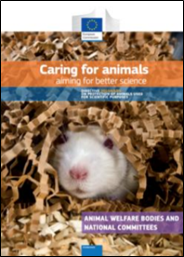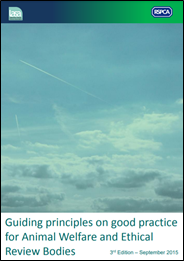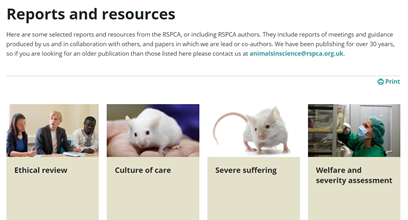The Animal Welfare Body (AWB) – A catalyst for progress

European Union Directive 2010/63 on the ‘protection of animals used for scientific procedures’ requires each user, breeder and supplier of lab animals to have an Animal Welfare Body (AWB). The AWB is expected to provide internal oversight and guidance on animal welfare and the 3Rs (replacement, reduction and refinement); establish and review operational processes for monitoring and following up on animal welfare; review the progress and outcomes of projects using animals; and to have a positive role in the preparation of project proposals. The AWB also plays a fundamental role in developing and maintaining an appropriate ‘Culture of Care’.
A European Commission Review of Directive 2010/63 (2017) reported significant benefits of the AWB, such as animal welfare improvements, including refinement of procedures, and better experimental design. This was good news, but several issues were also identified that might prevent some AWBs from effectively delivering their tasks. These included a lack of authority and resources for some AWBs, lack of clarity regarding roles and responsibilities, and concerns about training for AWB members.
With this in mind, the Royal Society for the Prevention of Cruelty to Animals (RSPCA) Animals in Science Department and the European Federation of Pharmaceutical Industries and Associations (EFPIA) Research and Animal Welfare group convened a webinar meeting in June 2021 to help advance and harmonise current good practice among AWBs.
Around 500 individuals, from at least 20 European Member States, joined the webinar. We conducted a survey before the meeting, which received 104 responses. Just under 50% were from academic establishments and just over 20% were from the pharmaceutical sector. Other responses included individuals from contract research organisations (CROs), not for profit and government organisations, public health laboratories and laboratory animal breeding organisations.
We asked participants how effectively their AWB performed the following tasks:
- Advise the staff dealing with animals on matters related to the welfare of animals, in relation to their acquisition, accommodation, care and use
- Advise the staff on the application of the requirement of the 3Rs, and keep them informed of technical and scientific developments concerning the application of those requirements
- Establish and review internal operational processes as regards monitoring, reporting and follow-up in relation to the welfare of animals housed or used in the Establishment
- Follow the development and outcome of projects, taking into account the effect on the animals used, & identify and advise as regards elements that further contribute to the 3Rs
The rating scale for responses was 1 to 7 (1 being the lowest and 7 the highest). For all questions, the rating of 5 was the most frequent response; in other words, most individuals scored their AWB as effective when self-assessing. We noted that CROs and the pharmaceutical sector generally self-assessed their AWB’s effectiveness in delivering the tasks slightly higher than academia. Reasons for this were discussed in the workshop. For example, industry generally has a more central, corporate approach and sets expectations regarding the management of governance and social responsibility matters. Responses to other questions such as ‘is your AWB supported and empowered’ and ‘are staff aware of what the AWB does’ were also equally positively self-assessed, with 5 as the most frequent score.
Barriers to effective working and possible solutions
We asked survey respondents to share any obstacles to delivering their tasks. Two common responses were time constraints and the lack of good (or any) AWB training resources and guidance. A number of ideas were proposed at the webinar to overcome these obstacles, including:
- Increasing the number of AWB networks within Member States. Some Member States already have an AWB network (e.g., Belgium and the UK). A member of the Belgian network presented a number of benefits for AWBs, such as being able to discuss and share problems more widely across different types of institution. The topic of AWB networks has been proposed for the FELASA 2022 meeting.
- Developing EU training modules for AWB members. AWB members need to be trained for their specific tasks, including knowledge of the legislation, what the AWB does, the scientific research at the institution and ‘committee skills’. Some of this training will need to be done in-house, but other information will be generic and would benefit from EU-wide, core modules.
- Finding mechanisms to better disseminate some of the AWB resources already available.
In summary, people generally felt positive about the current effectiveness of their AWBs. Many have veterinarians as full members, with animal technician involvement, good outreach and discussion. Challenges around having the time to prioritise AWB tasks and training and guidance were identified. The RSPCA and EFPIA will look at mechanisms to create solutions for these challenges.
This post was written by Sally Robinson, Chair of the European Federation of Pharmaceutical Industries and Associations (EFPIA/AstraZeneca) and Penny Hawkins, Head of the Animals in Science Department, Advocacy and Policy Directorate (RSPCA).
Further information and resources for AWBs:
You can watch the webinar here (3 h 52 min) and see the agenda here.
Guiding principles on good practice for Animal Welfare and Ethical Review Bodies
More information on ethical review
Top image of post by Tibor Janosi Mozes on Pixabay








Join the FEBS Network today
Joining the FEBS Network’s molecular life sciences community enables you to access special content on the site, present your profile, 'follow' contributors, 'comment' on and 'like' content, post your own content, and set up a tailored email digest for updates.